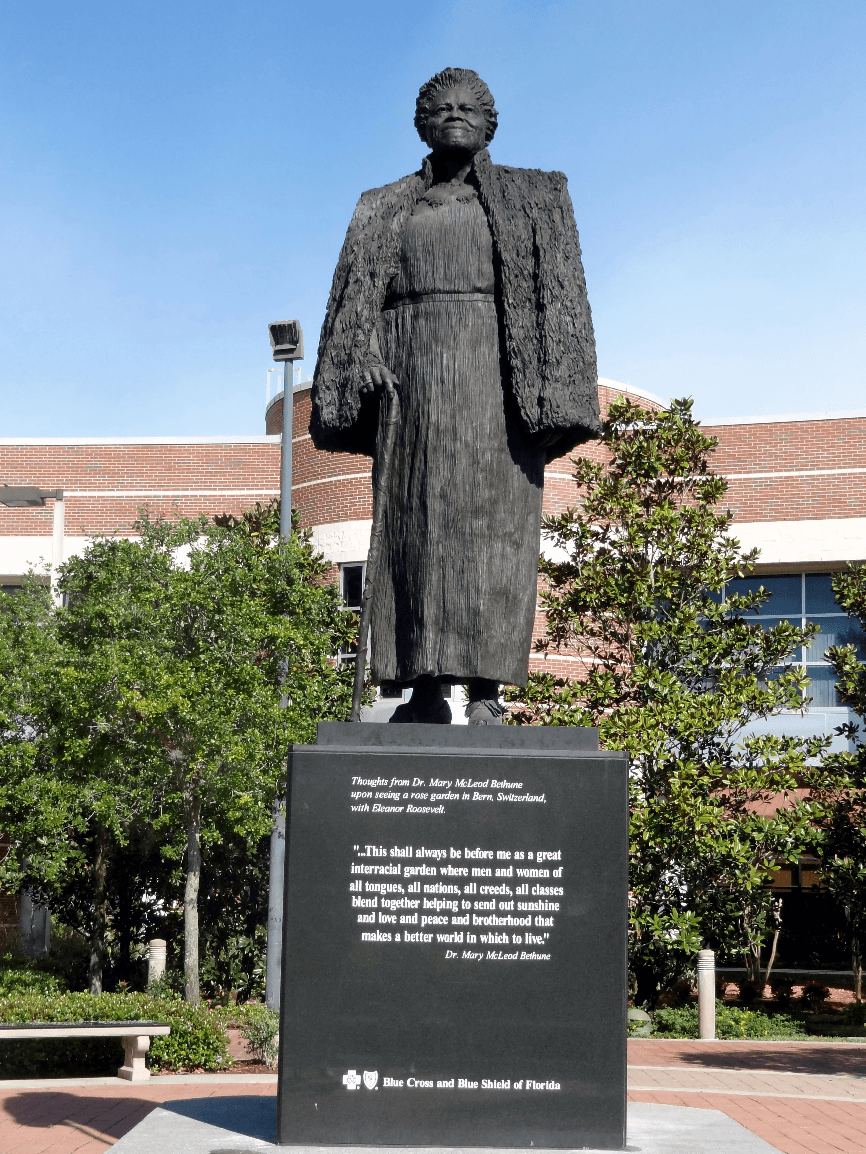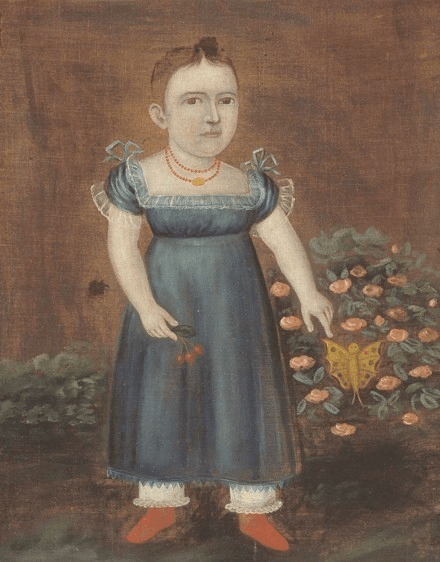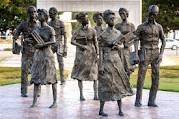By using the cotton gin, invented in 1793, a man could deseed and clean cotton more efficiently. Using a horse to turn this machine, it could clean about 50 times as much cotton as before. It quickly made cotton the leading crop in the South and the chief export crop for the region. For example, in 1803 alone, over 20,000 enslaved blacks were brought into Georgia and South Carolina to work in the cotton fields. Who invented the cotton gin?
Eli Whitney
section 1
She earned a degree from Moody Bible Institute in Chicago, but was rejected to be a Presbyterian missionary. She moved to Daytona Beach, Florida, became a teacher and decided to open her own school for girls which later merged with Cookman Institute. Friend of First Lady, Eleanor Roosevelt. Influential member of President Franklin Roosevelt’s Black Cabinet. Supported many causes related to women, youth, equal rights, jobs, and anti-lynching legislation.
- "If our people are to fight their way out of bondage, we must arm them
with the sword and the shield and the buckler of pride—belief in themselves and their possibilities based upon a sure knowledge of the past. That knowledge and pride we must give them—if it breaks every back in the kingdom." (Journal of Negro History, January 1938).
Name her.
Mary McLeod Bethune
Section 2/ Words of Wisdom/Landmark Statue in Fl.

In the mid 1400s, the Portuguese and Spanish sailors began frequent raids of West African coastal countries such as Senegal, Guinea, Ghana, and the Ivory Coast to capture Africans and sell them to the wealthy. By 1449, it is believed that about how many Africans lived in Portugal alone?
about 900
What is the name of the system begun in Virginia by which planters could claim 50 acres of land for each indentured servant brought into the colony?
Headright System
Section 1
This case declared the Plessy V. Ferguson decision separate but equal to be unconstitutional. Name this case.
Brown v. Board of Education Topeka Kansas 1954
Section 3/Court Cases
In West Africa three great empires emerged between AD 500 and 1600. Each had a powerful army and controlled great wealth. Name these powerful African empires.
Ghana, Mali, Songhai
This important civil rights group was organized in New York City on February 12, 1909. Its purpose was to advance the civil rights of African American people and to protect the rights of all people. This organization has become one of the major civil rights organizations today. Name it.
National Association for the Advancement of Colored People (NAACP)
The first known incident of an African becoming enslaved in the United States occurred in 1640 when this person ran away with two white servants. After their capture, the white servants had their work time increased by five years, while the African became a "servant for life". Name him.
John Punch
She made at least 19 trips into the South and helped an estimated 300 enslaved black people escape to freedom–including her parents and several of her brothers and sisters. She had escaped from slavery in Maryland in 1849. Slaveholders had a $40,000 reward for her capture. She was known as “Moses of her People.” She lived for eight years in St. Catherines in Canada and then moved to a home in Auburn, New York where she lived until she died at 96 years of age. Name her.
Harriet Tubman
In what year did Maryland pass a law that recognized slavery as legal?
1664
On May 28, 1830, President Andrew Jackson signed this law that literally forced the Cherokees, Creeks, Chickasaws, Choctaws, and Seminoles off their land in the south- eastern region of the United States and moved them over the “trail of tears” to Oklahoma. Many black persons who were members of these tribes also moved along the “trail” with Native Americans. Name the act.
Indian Removal Act
“First Successful African American Artist”
it is generally accepted that he came to Baltimore in the 1790s. Name him and the artwork.
came to Baltimore in the 1790s. Name him and the artwork.
Joshua Johnson
Portrait of Adelia Allender
The first African American church (under African American leadership) was established in 1773 or "a year or two before the Revolutionary War" in this southern city. It was established on "Mr. Galphin's estate." Rev. David George, who was one of the constituent members, was the first regular pastor of this church. Name the church and the city and state where it was located?
Silver Bluff Church, Silver Bluff, South Carolina
On February 18, 1688, what group adopted the first formal anti-slavery resolution in American history? They called slavery the "traffic of mensbody."
Quakers
He was the first African American writer to have a long-running Broadway hit. It happened when his play, Mulatto, opened at the Vanderbilt Theatre on October 24, 1935 and ran for 373 performances until December 9, 1937.
Words of Wisdom quote..
"I swear to this Lord,
I still can't see,
Why Democracy mean,
everybody but me."
Name this writer.
Langston Hughes
In the mid-19th century, people who were anti-slavery and those who were supporters of women’s rights were allies. Those who spoke openly for one frequently did so for the other. This woman traveled throughout the country giving speeches on both issues. In 1852, she attended the second National Woman Suffrage Convention in Akron, Ohio. When she asked to speak before the group, they reluctantly agreed, and this 6’ tall black woman spoke eloquently and comfortably before an audience of women of wealth and education. In her speech she said, “Look at me! Look at my arms! I have plowed and planted and gathered into barns and no man could beat me--and ain’t I a woman? I could work as much and eat as much as a man, when I could get it, and bear the lash as well--and ain’t I woman?” A monument marks the site of this woman’s speech in Akron. Name this abolitionist and feminist.
Sojourner Truth
During the American Revolution (1775-1783), many black men fought for the colonies and a larger number fought for the British. This was not the first time that black men had been soldiers. They served in the French and Indian Wars (1689-1763) and were members of various colonial militias. They enlisted in these wars with the hope that freedom for the colonies would also mean an end to slavery or their personal freedom. They were soldiers at the Battles of Lexington and Concord. Peter Salem fired the fatal shot killing the British Commander at Bunker Hill. Approximately how many black men fought for the colonies during the American Revolution?
5,000
On September 18, 1850, President Millard Fillmore signed a law that many called “the slaveholder's dream"--a law that required citizens and federal officers to become diligent slave catchers. The law provided the prompt return of enslaved blacks to slave owners and denied fugitive enslaved blacks a trial by jury or the right to testify on their own behalf. People suspected of being a runaway slave could be arrested without warrant and turned over to a claimant on nothing more than his sworn testimony of ownership. Officers capturing a fugitive slave were entitled to a fee and this encouraged some officers to kidnap free blacks and sell them to slave owners. Also, anyone who knowingly blocked a fugitive’s arrest could be fined as much as $1,000 for each offense. Name the law.
Fugitive Slave Law of 1850
ruling-discrimination in Washington, D.C. restaurants was illegal. “restaurants could not legally refuse to serve “well-behaved and respectable” black patrons. This decision was the result of protests led by activist Mary Church Terrell.
Name this court case.
District of Columbia v. John R. Thompson Co., Inc.
By 1860, approximately 500,000 free blacks resided in the country--46 percent of them lived in the South and 44 percent in the North. Most of them lived in highly industrialized urban centers. Which city had the largest number of free blacks at this time?
Baltimore, Maryland
The first all-black volunteer regiment of the Civil War in the North was organized in 1863. Frederick Douglass and other notable blacks volunteered their time in recruiting blacks to serve in this regiment of the Union Army. Today, a bronze sculpture of the Infantry Regiment stands in Boston's Common Garden, across from the State House. Name this regiment that is honored with this memorial.
54th Massachusetts Colored Infantry Regiment
In 1973, this outfielder of the Atlanta Braves' baseball team, hit home run number 715, breaking Babe Ruth's record. He started his professional baseball career with the Indianapolis Clowns of the Negro Baseball League. In his first year in the majors, he was selected Rookie of the Year in 1954. In 1956, he won the National League batting title and in 1957, the Most Valuable Player Award. He retired from baseball in 1976 with 755 total home runs. He set a National League record with 2,297 RBIs. Name him.
Hank Aaron
In 1910, this woman established a hair-products manufacturing company that eventually employed about 3,000 workers. In her early life, she had worked as a washerwoman, but invested her wages to develop a hair conditioner for women. She is the first African American woman to become a millionaire by her own efforts. She gave much of her money to charities that benefited African American communities. Name her.
Madame C. J. Walker
By the end of the 1770s, only about 50,000 African Americans lived in the northern colonies. About how many lived in the southern colonies?
400,000
In response to the freedoms given to blacks by amendments to the U.S. Constitution, southern states passed laws that placed severe restrictions on these freedoms. These included prohibiting their right to vote, forbidding them to sit on juries, limiting their right to testify against white men, carrying weapons in public places and working in certain occupations. What were these laws called?
Black Codes
In 1888, this inventor became first African American woman to receive a patent. She had designed a “cabinet bed” that folded out into a writing desk. Her invention was particularly important because urban living spaces at the time were extremely cramped. Name her
Sarah Goode
On September 23, 1957, a crowd of whites gathered in front of this high school to prevent nine black students from enrolling in the school. Violence erupted and the school superintendent was forced to withdraw the black students from the school under heavy police protection. Name the school, city, and state
Central High School; Little Rock, Arkansas
Section 3/ Monument
This group of black soldiers served in the U.S. Army Air Force. During their period of active service, they amassed one of the most impressive records of any airmen--150 Distinguished Flying Crosses, one Legion of Merit, one Silver Star, fourteen Bronze Stars, and 744 Air Medals. They flew over 15,500 sorties and 1,578 completed missions and destroyed 409 enemy aircraft. During the 200 missions in which they escorted heavy bombers deep into Germany's Rhineland, not one of the "heavies" was lost to enemy fighter opposition. Name the group.
Tuskegee Airmen
In 2015, this African American scientist has received high recognition for his "extraordinary role in exciting the public about the wonders of science". He has received the NASA Public Service Medal, the highest honor NASA gives to anyone who is not a government employee. In 2014, he was the host of a television series Cosmos: A Spacetime Odyssey. Since 1996, he has been the Director of the Hayden Planetarium at the Rose Center for Earth and Space in New York City. Name this astrophysicist, author, and science communicator.
Neil deGrasse Tyson
In July 2016, this African American, a longtime leader of the Enoch Pratt Free Library system in Baltimore, was sworn in as the 14th Librarian of Congress for a 10-year term. She was nominated by President Barack Obama and confirmed by the U.S. Senate. She is the first woman and the first African American to serve as chief executive of the Library of Congress—the largest library in the world. She was widely known for her innovative programs at the Enoch Pratt including those targeting children and college-bound students. She made the library a safe and welcoming place for those of all ages. Name her.
Carla Hayden
Throughout the entire period of European slave trading, about 95% of the enslaved Africans are believed to have been distributed to South America, Latin America and the Caribbean. In fact, it was the largest forced migration of people in world history.A small percentage of these enslaved Africans ended up in British North America. The Atlantic slave trade created many industries throughout Europe, including a large and thriving shipbuilding industry. This shipbuilding industry created colonial rule and European domination in many parts of the world. It set England on the path to becoming the British Empire. As a result, the buying and selling of human cargo became a major part of the world's economy. How many Africans were transported to the Americas?
approximately 10 million
On January 1, 1863, President Abraham Lincoln issued a presidential order that freed enslaved black people in the Confederate states. Some believe he did this to weaken the Confederacy as well as to generate favorable world opinion. Name the presidential order.
Emancipation Proclamation
The largest and only national museum devoted exclusively to the documentation of African American life, history, and culture opened to the public in Washington, D.C. on this date—September 24, 2016. The museum has collected more than 36,000 artifacts and nearly 100,000 individuals have become charter members. It is open to all who are interested in African American culture and helps all Americans see how their stories, their histories, and their cultures are shaped and informed by global influences. It encourages all Americans to participate, collaborate, and learn more about African American History and culture. Name this museum.
National Museum of African American History and Culture
A group of young people, black and white, traveled by bus from Washington to New Orleans to test desegregation of facilities at bus depots in 1961. They were attacked on May 14, 1961 by mobs of white racists in Anniston and Birmingham, Alabama. U.S. Attorney General Robert F. Kennedy telephoned Alabama officials, asking them to guarantee protection for the integrated travelers. Their action helped to influence the Interstate Commerce Commission (ICC) to rule that segregation in interstate travel facilities was illegal. What was this group called?
"Freedom Riders"
Section 3